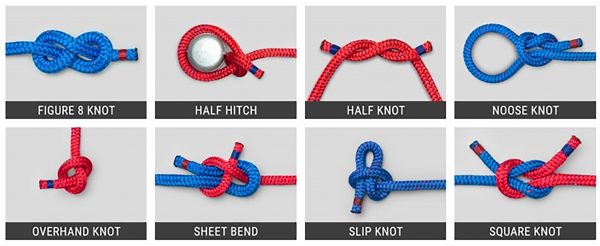Rigger kink is a form of BDSM (Bondage, Discipline, Sadism, and Masochism) that involves one person, known as the rigger, tying and binding another person, known as the rope bunny or bottom, using ropes or other materials.
It is a sexual fetish for erotic pleasure, and the goal is often to create a sense of vulnerability and trust between partners while exploring boundaries and engaging in consensual power exchange.
This article will overview rigger kink, its origins and history, psychological, emotional, and physical aspects, and related terminology and concepts.
Rigger Kink Origin and History
Using ropes for bondage can be traced back to ancient civilizations such as Egypt and Rome. However, the modern form of rigger kink has its roots in the Japanese martial art of Hojōjutsu, which was used to restrain and immobilize captives during the Edo period (1603-1868).
This technique later evolved into the erotic art of Shibari or Kinbaku, which focuses on the aesthetics and sensuality of rope bondage.
Rigger kink gained popularity in the Western world during the mid-20th century through the emergence of the BDSM subculture and the works of artists like John Willie and his comic strip character Sweet Gwendoline. The growth of the internet and online communities further contributed to the spread of rigger kink, allowing kink stars to share techniques and experiences and connect with like-minded individuals.
Understanding Rigger kink
Psychological aspects
Rigger kink, like other forms of BDSM, involves complex psychological dynamics between the participants. To fully understand this type of kink, it is important to consider the various psychological aspects that come into play during a rigger kink scene.
Dominance and submission
One of the key elements of rigger kink is the power exchange between the rigger (dominant) and the rope bunny or bottom (submissive). This dynamic allows both partners to explore their desires and
fantasies in a controlled and consensual environment. The dominant partner asserts control by tying and restraining the submissive, while the submissive surrenders their freedom and autonomy. This exchange can be emotionally and sexually arousing for both parties and foster a deep intimacy and connection.
Trust and communication
Trust and communication are essential components of any BDSM relationship, and rigger kink is no exception. The submissive partner places their physical and emotional well-being in the hands of the dominant, trusting that they will respect their boundaries and maintain their safety.
In turn, the dominant partner must be attentive to the submissive’s needs and responsive to their verbal and non-verbal cues.
Open and honest communication is critical for establishing and maintaining trust in a rigger kink relationship. This includes discussing desires, boundaries, and potential health concerns before engaging in a scene. Regular check-ins during the scene can also help ensure the submissive’s well-being and allow adjustments as needed.
Consensual non-consent
Consensual non-consent (CNC) is a concept sometimes explored in rigger kink and other BDSM activities. It involves role-playing scenarios in which the submissive appears to be non-consenting or resisting, even though they have previously agreed to the scene and established boundaries with their partner.
CNC can be an exciting and arousing experience for some participants, allowing them to explore darker fantasies in a safe and controlled environment. However, both partners must communicate openly about their desires and limits and establish safe words to ensure the scene remains consensual and enjoyable.
Rigger Kink Physical aspects
Rigger kink involves not only psychological dynamics but also various physical aspects that are essential to creating a safe and enjoyable experience. Understanding the different rope materials and types, safety precautions, and basic knots and techniques can help riggers and rope bunnies get the most out of their rigger kink scenes.
Rope materials and types
Various rope materials can be used in rigger kinks, each with unique properties and characteristics. Some common materials include:
Natural fiber ropes
These ropes are made from materials like hemp, jute, or cotton. Many practitioners prefer them for their texture, which provides a good grip and minimizes slipping. Natural fiber ropes also hold knots well and can be easily dyed for aesthetic purposes.
Synthetic ropes
These ropes are made from nylon or polyester. They are often more affordable and easier to maintain than natural fiber ropes. Synthetic ropes are less prone to fraying and can be more comfortable against the skin. However, they may have more stretch and slipperiness than natural fibers, making some knots and techniques more challenging.
Safety precautions
Safety is of the utmost importance in rigger kink. Both riggers and rope bunnies should be aware of the potential risks and take precautions to minimize them. Some safety precautions to consider include:
Open communication
Discuss boundaries, desires, and any health concerns before engaging in a rigger kink scene. Establish safe words and check in regularly throughout the scene to ensure the comfort and well-being of both partners.
Proper technique
Rigging should be done with care to avoid causing injury to the submissive partner. This includes avoiding knots that can tighten and cut off circulation and avoiding pressure on sensitive areas or joints.
Monitoring circulation
Check the color and temperature of the bound body parts regularly to ensure proper blood flow. If there is any numbness, tingling, or loss of sensation, the rigger should adjust or remove the bindings immediately.
Emergency equipment
Keep a pair of safety scissors or EMT shears on hand during rigger kink scenes to quickly cut through ropes in case of an emergency.
Rigger Kink Basic knots and techniques
While rigger kink can involve a wide range of knots and techniques, some basic ones to start with include:
Single-column tie
This is a foundational knot that binds a single limb or body part, such as a wrist or ankle. The single-column tie ensures that the rope does not tighten when pressure is applied, which helps to prevent circulation issues.
Double-column tie
Similar to the single-column tie, this knot is used to bind two limbs or body parts together, such as both wrists or ankles.
Harnesses and body ties
These techniques involve tying ropes around the torso, chest, or hips to create visually appealing patterns or provide support during suspension scenes.
Friction and wraps
These techniques are used to secure knots and distribute pressure across a larger area to minimize discomfort and reduce the risk of injury.
Rigger Kink Emotional aspects
In addition to the psychological and physical aspects of rigger kink, the emotional elements are also crucial.
Understanding the emotional aspects of rigger kink, such as connection and intimacy, aftercare and emotional support, and managing potential risks and complications, can lead to a more fulfilling and rewarding experience for both the rigger and the rope bunny.
Connection and intimacy
The power exchange and vulnerability inherent in rigger kink can foster a deep connection and intimacy between partners. The trust and communication required for a successful scene allow participants to explore their desires and boundaries while building a strong bond.
For many people, this emotional aspect is a key component of the appeal of rigger kink, as it offers an opportunity to experience a unique level of closeness with their partner.
Aftercare and emotional support
Aftercare is an essential part of any BDSM scene, including rigger kink. Aftercare involves providing emotional support and care for both the rigger and the rope bunny after the scene has concluded. This may include cuddling, gentle touch, soothing words, or any other activity that helps partners reconnect and come down from the scene’s intensely emotional and physical experiences.
Aftercare is important because it helps ensure both participants’ emotional well-being and can help prevent feelings of abandonment or emotional drop, which can sometimes occur after intense BDSM activities. Open communication during aftercare can also allow both partners to discuss their experiences, address any concerns, and deepen their connection.
Managing potential risks and complications
As with any BDSM activity, there are potential emotional risks and complications associated with rigger kink. These may include feelings of shame, guilt, confusion about their desires, and potential misunderstandings or miscommunications between partners.
To manage these potential risks, it is essential for both the rigger and the rope bunny to maintain open and honest communication about their desires, boundaries, and emotional needs. By establishing a strong foundation of trust, both partners can navigate the emotional complexities of rigger kink and ensure that the experience is enjoyable and fulfilling for all involved.
Rigger Kink Terminology and Related Concepts
Rigger
The person who ties or binds the submissive partner. They take on a dominant role and are responsible for the safety and well-being of the rope bunny or bottom.
Rope bunny/bottom
The person who is tied or bound by the rigger. They assume a submissive role and experience physical and emotional sensations from being restrained.
Shibari/Kinbaku
The Japanese art of rope bondage emphasizes the aesthetics and sensuality of the knots and ties. Shibari is often considered a more intricate and artistic form of rope bondage compared to Western styles.
Suspension
A form of rigger kink in which the rope bunny is suspended off the ground using ropes and rigging equipment. This can create intense sensations and requires a higher level of skill and safety precautions on the part of the rigger.
Safety
As with any BDSM activity, safety is paramount in rigger kink. Participants must communicate openly about their limits, desires, and any potential health concerns. Establishing safe words and regularly checking in with one another is crucial to ensure a positive and consensual experience.
Rigger Kink Final Thoughts
In conclusion, rigger kink is a multifaceted BDSM practice combining psychological, emotional, and physical elements to create a unique and intimate experience for riggers and rope bunnies.
By prioritizing open communication, safety, and understanding the various aspects of this practice, participants can foster a deep sense of connection and trust, leading to a mutually satisfying and rewarding experience.
Rigger kink highlights the importance of exploring personal desires and boundaries within a consensual and supportive environment.























